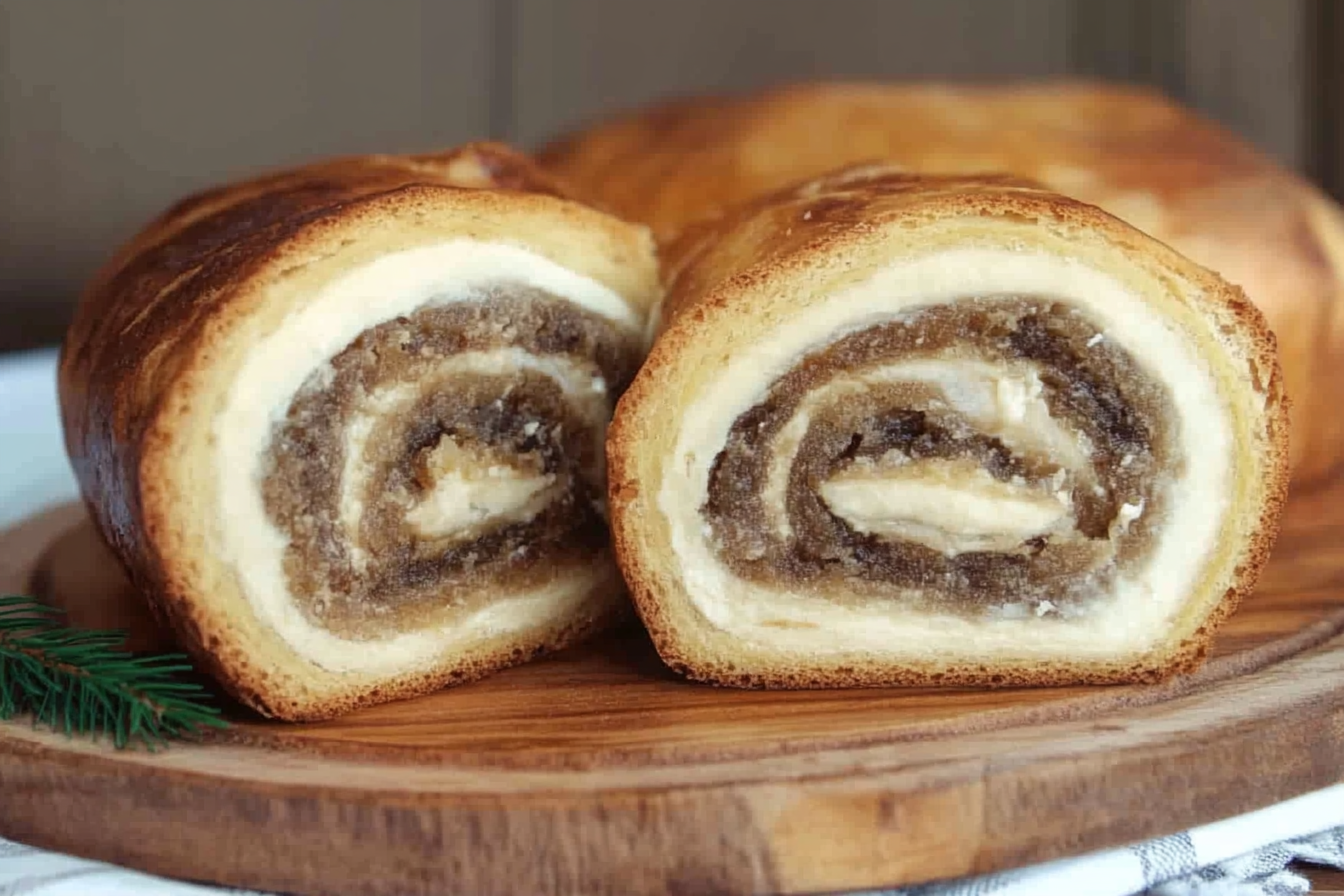Historical Background of Potica
Potica, pronounced poh-TEET-sah, is a traditional Slovenian dessert that has transcended borders and time to become a symbol of heritage and festivity in Central Europe. This rolled sweet bread, known for its intricate swirls of filling, has roots that date back centuries. Originating from Slovenia, potica reflects the region’s culinary ingenuity, blending local ingredients into a treat fit for special occasions like Easter, Christmas, and weddings.
In Slovenia, potica is more than just food; it is a cultural emblem. The dish’s significance is evident in its preparation, often passed down as family recipes. The process of making potica brings communities together, fostering a sense of pride and tradition. Whether baked in earthenware tins or modern loaf pans, potica remains an enduring culinary art that celebrates family and flavor.
Ingredients Used in Potica
Types of Nuts
The most traditional filling for potica features ground walnuts, giving it a rich and nutty profile. Walnut potica is considered the gold standard, but variations with almonds, hazelnuts, or pecans are also cherished. For a different twist, some recipes incorporate carob or poppy seeds, offering unique flavors to suit individual preferences.
Other Common Fillings
Beyond nuts, potica embraces a range of fillings that reflect local and seasonal availability. Popular choices include:
- Cottage cheese: For a creamy and mildly tangy option. Explore cottage cheese recipes for inspiration.
- Honey and cinnamon: Providing a warm and fragrant sweetness.
- Chocolate with cinnamon: Adding a decadent twist.
- Tarragon and quark: A savory variation popular in certain regions. These diverse fillings ensure that potica can cater to every palate, from the traditionalist to the adventurous.
Dough Preparation
The foundation of potica lies in its dough, a yeasted and enriched mixture that is both tender and pliable. Crafting the perfect dough is an art that requires patience and precision.
Essential Ingredients for the Dough
To achieve the ideal texture, these ingredients are indispensable:
- All-purpose flour or bread flour: Provides structure.
- Active dry yeast: For leavening.
- Warm milk: Activates the yeast and softens the dough.
- Eggs: Adds richness.
- Unsalted butter: Imparts a tender crumb.
- Pinch of salt: Balances the flavors.
- Sugar: Enhances sweetness.
Step-by-Step Dough-Making Process
- Activate the Yeast: Combine active dry yeast with warm milk and a teaspoon of sugar. Let it foam for 5-10 minutes.
- Mix Dry Ingredients: In a large bowl, add all-purpose flour, a pinch of salt, and sugar.
- Combine Wet Ingredients: Mix the yeast mixture, melted butter, and eggs. Slowly incorporate into the dry ingredients.
- Knead: On a floured surface, knead the dough until smooth and elastic, about 8-10 minutes.
- Rest: Place the dough in an oiled bowl, cover with plastic wrap, and let it rise in a warm place until doubled, approximately 1-2 hours.
Making the Filling
The filling is the heart of potica. A well-prepared filling ensures that each bite is a burst of flavor.
Grinding Walnuts Techniques
For the walnut filling:
- Use a food processor to grind walnuts into a fine meal, ensuring a uniform texture.
- Combine ground walnuts with sugar, warm milk, vanilla extract, and a dash of cinnamon for depth. The mixture should be thick yet spreadable.
Seasonal Variations in Fillings
Seasonality influences potica fillings. Spring versions might feature poppy seeds, while winter calls for spiced nut fillings. Summer potica might embrace fruits like dried apricots or raisins.
For sweet treats to pair with potica, try the butter pecan pound cake.
Assembling Potica
Once the dough and filling are prepared, the assembly process begins. This step requires careful attention to achieve the signature spirals.
Rolling and Shaping Techniques
- Roll the dough on a floured cloth into a 36×60-inch rectangle.
- Spread the filling evenly, leaving a small border to seal.
- Use the cloth to gently roll the dough jelly-roll style.
- Pinch the edges to secure the roll.
Tips for Even Filling Distribution
- Spread the filling in spoonfuls before smoothing it out.
- Avoid overloading to prevent tearing during rolling.
- Ensure an even layer for consistent flavor.
Baking Potica
Baking transforms potica from a doughy roll into a golden masterpiece.
Preparing the Pan
Grease loaf pans or baking tins with butter. Dust with flour to prevent sticking. Alternatively, line with parchment paper for easy removal.
Recommended Baking Temperatures and Times
Bake potica in a preheated oven at 350°F (175°C) for 50-60 minutes. Rotate the pans halfway through to ensure even baking. A convection oven may reduce baking time slightly.
Serving Suggestions
Traditional Accompaniments
Serve potica with a dusting of powdered sugar and a side of cream for dough-like richness. A cup of warm milk or coffee enhances its comforting qualities.
Modern Twists on Serving Potica
Try pairing potica with ice cream or drizzling slices with honey for a modern dessert twist. Savory potica variations can accompany cheese boards or salads.
Storing and Freezing Potica
Best Practices for Freezing
Wrap potica tightly in plastic wrap and place in an airtight container. Freeze for up to three months to preserve freshness.
Thawing and Reheating Tips
Thaw at room temperature, then warm in a 300°F (150°C) oven for 10 minutes to restore its fresh-baked flavor.
Variations and Adaptations
Cultural Influences on Potica Recipes
Potica recipes vary across Central Europe, with each region adding its flair. For example, Hungarian nut rolls and Polish makowiec share similarities but differ in dough and filling styles.
Unique Regional Twists
- Croatian Potica: Often incorporates dried fruits and citrus zest.
- Austrian Potica: Leans toward buttery doughs with almond fillings.
Community Engagement
Reader Reviews and Testimonials
Many potica enthusiasts have fond memories of family recipes. “My grandmother’s walnut potica is still the best,” shares a reader. Others praise the versatility, noting, “It’s the ultimate holiday dessert!”
Sharing Personal Potica Experiences and Tweaks
Readers often experiment with fillings or shapes, adding personal touches like using cinnamon powder or incorporating chocolate chips. Such adaptations keep potica evolving while honoring its roots.
Conclusion Potica’s charm lies in its combination of simplicity and sophistication. Whether you follow a traditional walnut recipe or experiment with modern fillings, making potica is a rewarding experience. It’s more than a dessert; it’s a slice of history, a testament to Central European ingenuity, and a delicious way to bring people together.

